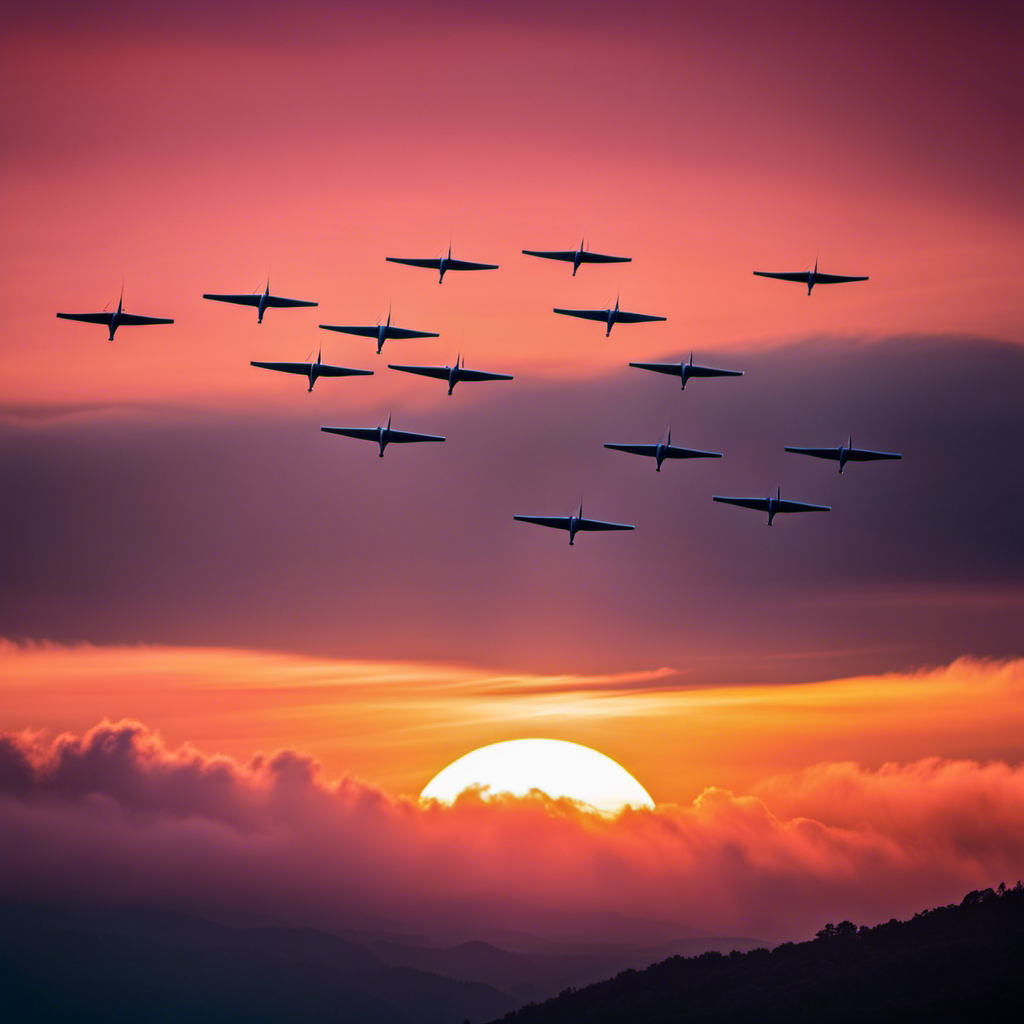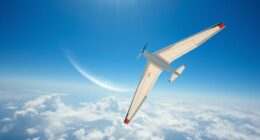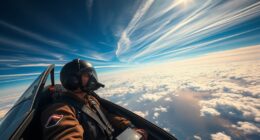Are glider cabins pressurized?
It’s a question that often comes to mind when considering the unique world of glider aviation. As a pilot myself, I’ve always been intrigued by the functionality and limitations of these aircraft.
In this article, we will delve into the intricacies of gliders and explore why they lack pressurized cabins. We’ll also discuss the need for supplemental oxygen at higher altitudes and the potential challenges of implementing pressurized cabins in gliders.
So let’s embark on this journey to unravel the mysteries of glider aviation together.
Key Takeaways
- Gliders do not have pressurized cabins.
- Lack of pressurization affects both pilots and passengers.
- Gliders without pressurized cabins have altitude limitations.
- Supplemental oxygen is necessary for optimal performance.
What is a Glider?
A glider is a type of aircraft that you can fly without an engine. It is designed to be propelled by the natural forces of the air, such as thermals and updrafts. Gliders are typically made of lightweight materials like fiberglass or carbon fiber, which allows them to stay aloft for extended periods.
One of the advantages of gliding is the ability to soar silently through the sky, experiencing the freedom and tranquility that comes with flying. Gliders also have the advantage of being more cost-effective compared to powered aircraft, as they do not require fuel or maintenance for an engine.
Now, let’s delve into the functionality of glider aircraft, exploring their unique features and capabilities.
The Functionality of Glider Aircraft
Gliders aren’t typically equipped with pressurized cabins. As a glider pilot, I am well-versed in the functionality of these aircraft and the principles that govern their flight.
Glider aerodynamics play a crucial role in the performance of these remarkable machines. To convey a deeper understanding, let’s explore three key aspects:
-
Wing Design: Gliders have long, slender wings that generate lift efficiently, allowing them to stay aloft for extended periods.
-
Thermals and Ridge Lift: Glider flight techniques often involve exploiting rising air currents, such as thermals and ridge lift, to gain altitude and extend flight time.
-
Weight and Balance: Proper weight distribution is essential in glider aircraft to maintain stability and control during flight.
Understanding these factors is vital for a glider pilot to maximize their flight experience and ensure safety.
Transitioning to the subsequent section, it is important to note the significant differences between gliders and commercial airplanes.
The Difference Between Gliders and Commercial Airplanes
The main distinction between gliders and commercial airplanes lies in their overall functionality and the absence of pressurized cabins in gliders. Gliders, also known as sailplanes, rely on glider technology to stay aloft without the need for an engine. These aircraft are designed to soar gracefully through the air using only the forces of nature, such as thermals and updrafts.
One of the advantages of glider aviation is its simplicity and cost-effectiveness compared to powered flight. Gliders offer a unique experience for pilots, allowing them to connect with the elements and experience true freedom in the sky. However, gliders do not have pressurized cabins like commercial airplanes do, which limits their altitude capabilities and requires pilots to use supplemental oxygen at higher altitudes.
Moving forward, let’s explore the implications of the lack of pressurized cabins in gliders.
The Lack of Pressurized Cabins in Gliders
One of the drawbacks of not having pressurized cabins in sailplanes is the limitation it places on altitude capabilities. Without pressurization, gliders are unable to fly at higher altitudes where the air is thin and oxygen levels are low. This has several implications for both pilot performance and the health of passengers on board.
-
Impact on pilot performance: At higher altitudes, the reduced oxygen levels can lead to hypoxia, which affects cognitive function and decision-making abilities. This can compromise the safety of the flight and the pilot’s ability to navigate and control the glider effectively.
-
Health effects on passengers: Passengers in non-pressurized gliders may also experience discomfort and potential health issues due to the lack of oxygen. Symptoms can range from mild headaches and fatigue to more severe conditions like altitude sickness or even hypoxia.
With these limitations in mind, it becomes evident why supplemental oxygen is necessary at higher altitudes for both pilots and passengers. The need for oxygen is crucial to maintain optimal performance and ensure the well-being of everyone on board.
The Need for Supplemental Oxygen at Higher Altitudes
To fly at higher altitudes, you’ll need supplemental oxygen due to the thin air and low oxygen levels. The altitude effects on the body can be significant, especially above 10,000 feet.
At these heights, the air becomes less dense, resulting in a decrease in the amount of oxygen available for breathing. As a pilot, it is crucial to ensure that you have enough oxygen to maintain cognitive function, prevent hypoxia, and avoid impairments in judgement and decision-making.
Supplemental oxygen requirements vary depending on the altitude and duration of the flight. It is essential to have a clear understanding of the specific guidelines and regulations regarding supplemental oxygen usage.
Now, let’s explore the impact of non-pressurized cabins on pilots and passengers.
The Impact of Non-Pressurized Cabins on Pilots and Passengers
If you’re flying in an aircraft with a non-pressurized cabin, you may experience discomfort and potential health risks due to the rapid changes in altitude. The impact on health can be significant, as the physiological effects of flying at high altitudes without pressurization can be quite severe.
As the aircraft ascends, the air pressure decreases, leading to a decrease in oxygen levels. This decrease in oxygen can result in symptoms such as dizziness, shortness of breath, and even hypoxia. Additionally, the rapid changes in altitude can cause ear pain and discomfort due to the unequal pressure between the cabin and the surrounding environment.
These physiological effects highlight the importance of pressurized cabins in ensuring the safety and well-being of pilots and passengers during flight.
Moving on to the limitations of glider aviation…
The Limitations of Glider Aviation
The limitations of glider aviation are often related to the dependence on thermal updrafts and favorable weather conditions. One major limitation is the restriction in altitude that gliders can reach. Due to the absence of an engine, gliders cannot climb to high altitudes like powered aircraft. This limitation impacts pilot performance as it restricts the range and duration of flights.
Another limitation is the reliance on thermal updrafts for sustained flight. If the weather conditions do not provide sufficient thermal activity, gliders may struggle to stay aloft. These limitations require pilots to carefully plan their flights, taking into account the availability of thermals and suitable weather conditions.
Despite these limitations, gliders offer unique advantages, such as the ability to soar silently and the advantages of non-pressurized cabins.
The Advantages of Non-Pressurized Cabins in Gliders
You can enjoy the benefits of a non-pressurized cabin in a glider, such as a more natural and comfortable flying experience.
-
Reduced fatigue: Without pressurization, there is less strain on the body, allowing for longer flights without feeling fatigued.
-
Enhanced visibility: Gliders often have large windows, providing a panoramic view of the surroundings, giving pilots an unobstructed view of the sky and landscapes below.
-
Improved maneuverability: Gliders can fly at lower altitudes where the air is denser, enabling tighter turns and better control during flight.
-
Cost-effective: Since gliders don’t require complex pressurization systems, they are more affordable to operate and maintain.
These advantages make flying in a non-pressurized glider a popular choice for enthusiasts and professionals alike. However, it is essential to consider safety precautions when undertaking glider flights, ensuring a secure and enjoyable experience for all involved.
The Safety Precautions for Flying in Gliders
Transition: Now that we have explored the advantages of non-pressurized cabins in gliders, let’s delve into the safety precautions for flying in these aircraft. When it comes to glider operations, safety is of paramount importance. To ensure the well-being of pilots and passengers, various safety measures and emergency procedures are put in place.
One essential safety measure is conducting thorough pre-flight inspections to ensure the glider is in optimal condition. This includes checking the control surfaces, instrumentation, and structural integrity. Additionally, pilots must be well-versed in emergency procedures such as handling rope breaks, executing a forced landing, and managing in-flight emergencies.
To emphasize the importance of safety measures and emergency procedures in glider flying, let’s take a look at the following table:
| Safety Measures | Emergency Procedures |
|---|---|
| Thorough pre-flight inspections | Handling rope breaks |
| Regular maintenance checks | Executing a forced landing |
| Proper use of safety equipment | Managing in-flight emergencies |
By adhering to these safety measures and being prepared for emergencies, glider pilots can mitigate risks and ensure a safe flying experience.
Transition: Now that we understand the safety precautions in glider flying, let’s explore the training and certification requirements for glider pilots.
The Training and Certification Requirements for Glider Pilots
To become a glider pilot, it’s important to undergo comprehensive training and obtain the necessary certifications. The training requirements for glider pilots are rigorous and ensure that pilots have the skills and knowledge to safely operate gliders.
Pilots must complete a minimum number of flight hours, including solo flights and cross-country flights, under the supervision of a certified flight instructor. They must also pass written and practical exams that cover topics such as aerodynamics, meteorology, navigation, and emergency procedures.
Once the training requirements are met, pilots can then apply for certification through the appropriate aviation authority. The certification process involves submitting an application, providing proof of training and flight experience, and passing a final flight test.
With the proper training and certification, glider pilots can safely navigate the skies and explore the future of glider technology, including advancements in pressurized cabins. These advancements will enhance the comfort and safety of glider pilots during high-altitude flights.
The Future of Glider Technology and Pressurized Cabins
With advancements in technology, glider pilots like yourself can look forward to the future of safer and more comfortable flights through the use of pressurized cabins. As we explore the possibilities of pressurization in gliders, it’s important to understand the potential benefits it can bring.
Increased Safety: Pressurized cabins can protect pilots from rapid changes in altitude and maintain a constant internal pressure, reducing the risk of hypoxia and other altitude-related health issues.
Enhanced Comfort: By simulating lower altitudes, pressurized cabins can provide a more pleasant flying experience, minimizing the effects of temperature, humidity, and noise.
The Potential Risks and Challenges of Implementing Pressurized Cabins in Gliders
One of the potential risks of implementing pressurized cabins in gliders is the increased complexity and cost of the technology. Pressurized cabins provide numerous benefits such as increased comfort and safety for pilots, allowing gliders to fly at higher altitudes. However, this implementation also poses several challenges.
The design and construction of pressurized cabins require additional engineering expertise and meticulous attention to detail. Ensuring the structural integrity of the cabin and maintaining airtight seals can be demanding tasks. Moreover, the cost of installing and maintaining pressurized cabin systems can be significant, adding to the overall expense of glider production and operation.
These challenges must be carefully considered and addressed during the development and implementation of pressurized cabins in gliders.
Transitioning to the subsequent section, it is important to analyze the cost considerations of adding pressurized cabins to gliders.
The Cost Considerations of Adding Pressurized Cabins to Gliders
The cost of adding pressurized cabins to gliders can be a significant factor in the overall expense of production and operation. When considering the cost implications, it’s essential to take into account the technological feasibility of implementing pressurized cabins in gliders.
Here are some key points to consider:
-
Cost implications:
-
Pressurized cabins require complex engineering and construction, leading to higher production costs.
-
Maintenance and repair of pressurized systems can be expensive, requiring specialized training and equipment.
-
Technological feasibility:
-
The lightweight design of gliders may pose challenges in achieving the necessary structural strength for pressurization.
-
Ensuring airtight seals and maintaining structural integrity in high-altitude environments can be technically demanding.
Understanding the cost implications and technological feasibility is crucial in making informed decisions regarding the implementation of pressurized cabins in gliders.
Transitioning to the next section, it’s important to consider the global regulations and standards for glider aircraft.
The Global Regulations and Standards for Glider Aircraft
Global regulations and standards play a crucial role in determining the safety and operational requirements for glider aircraft. These regulations are put in place to ensure that gliders are built and operated in a manner that prioritizes the safety of pilots and passengers.
Safety standards cover various aspects, including design, construction, maintenance, and operation. They address important factors such as airworthiness, flight limitations, equipment requirements, and emergency procedures. These global regulations are formulated by international organizations like the International Civil Aviation Organization (ICAO) and are implemented by national aviation authorities.
Compliance with these regulations is essential for glider manufacturers and operators to ensure the safe and efficient operation of gliders worldwide.
Transition: Now that we understand the importance of global regulations and safety standards, it is essential to consider the role and importance of non-pressurized cabins in glider aviation.
The Conclusion: The Role and Importance of Non-Pressurized Cabins in Glider Aviation
Transitioning now to the role and importance of non-pressurized cabins in glider aviation, you’ll discover how these cabins affect the safety and comfort of pilots and passengers alike.
Non-pressurized cabins are a crucial component of glider aircraft, as they do not rely on supplemental oxygen systems. These cabins provide a natural flow of fresh air, ensuring a comfortable and breathable environment during flight.
While they may not offer the same level of pressurization as commercial airliners, non-pressurized cabins are designed to maintain a safe and adequate oxygen level for glider operations.
As future technology continues to evolve, advancements in cabin design and ventilation systems could further enhance the safety and comfort of glider aviation. It is imperative that pilots and passengers understand the importance of non-pressurized cabins and their role in ensuring a smooth and enjoyable gliding experience.
Frequently Asked Questions
Are there any advantages to having a non-pressurized cabin in gliders?
There are several advantages to having a non-pressurized cabin in gliders. It reduces weight, increases maneuverability, and simplifies construction. Additionally, it allows for a greater connection with the surrounding environment, providing a more immersive and exhilarating flying experience.
What are the limitations of glider aviation?
The limitations of glider aviation include the impact of weather on flights and the performance limitations of gliders. Weather conditions such as strong winds, turbulence, and low visibility can affect the safety and efficiency of glider operations.
What are the safety precautions for flying in gliders?
Safety measures for flying in gliders include conducting thorough pre-flight checks, ensuring proper equipment and emergency supplies are on board, and following established procedures for takeoff, landing, and in-flight operations to minimize risks and ensure the safety of the flight.
What are the training and certification requirements for glider pilots?
To become a glider pilot, rigorous training and certification are required. This includes completing a specified number of flight hours, passing written and practical exams, and demonstrating proficiency in gliding techniques and safety procedures.
What are the potential risks and challenges of implementing pressurized cabins in gliders?
Pressurizing glider cabins poses several challenges and risks. The main challenge is maintaining structural integrity due to increased pressure differentials. Risks include potential leaks, equipment failures, and the need for specialized maintenance and training.
Conclusion
In conclusion, the absence of pressurized cabins in gliders is a crucial aspect of their design and operation. Gliders are specifically designed to fly at lower altitudes, where the air is denser and provides the necessary lift. Adding pressurized cabins to gliders would not only be technologically challenging and costly, but it would also compromise the essence of glider aviation.
Imagine soaring through the sky, feeling the wind on your face, and experiencing the pure freedom of flight – that’s the beauty of gliders, and it’s something that shouldn’t be compromised.
Orion, better known as “Jetstream,” is the voice that brings the stories of the skies to life. His fascination with aviation began at a young age, sparked by his father’s tales of flying and adventure. Orion’s journey into the world of gliding was serendipitous, and from the moment he took his first glider flight, he knew he had found his calling.










